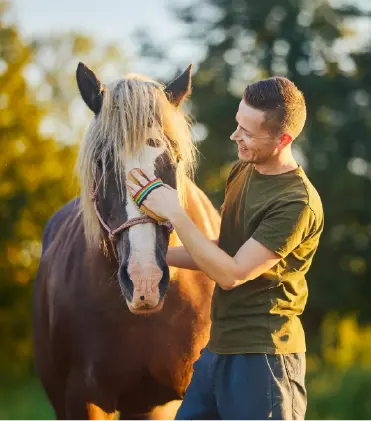What is the treatment?
Zootherapy is a type of therapy that provides holistic healing through interaction with animals to improve physical, emotional, and mental well-being. Zootherapy is also known as animal-assisted therapy (AAT) or pet therapy. Zootherapy is a type of individualized approach in which unique therapy is performed with specific animals to treat people with specific types of diseases. This therapy may include various animals such as dogs, cats, horses, dolphins, and even smaller creatures like rabbits and birds. Each individual chooses their favorite animal during the therapy for the maximum benefits. Zootherapy focuses on creating a calming and supportive environment where animals help to reduce stress and improve mood with improved social interaction.
Philosophy/Origin
Animals have been used for therapeutic purposes for centuries, as well as ancient practices. There is plenty of evidence from the past in which animals are being used to deal with loneliness and social anxieties. Modern zootherapy emerged in the 20th century, but it has been used since psychologist Boris Levinson noticed the benefits of animal interaction for children with developmental disorders. Zootherapy highlights the ability of animals to provide emotional support and healing power.
Physical Benefits
Mental/Emotional Benefits
Long-Term Wellness
Zootherapy encourages communication and builds a relationship of trust in the individuals. It helps to manage the symptoms of behavioral problems like anxiety, aggression, or impulsivity. Individuals who need to focus on memory and mental focus may benefit from this therapy. It is particularly for seniors or individuals with developmental problems.
Ideal Audience
Zootherapy is suitable for people of all ages, from children to the elderly. Children usually enjoy activities with animals and find them more comfortable. It is ideal for people looking for emotional support to manage mental health issues or recover from physical ailments.
Specific Conditions
The treatment of zootherapy involves the following important steps
Initial Assessment
In this stage, the therapist thoroughly evaluates the individual to understand their unique needs and preferences. The therapist asks about past experiences with animals, emotional goals, and expectations of each individual to animal-assisted therapy.
Animal Selection
The therapist selects an appropriate animal after the initial assessment. The temperament, size, and energy level of the animal are matched to the needs of each individual to create a positive and comfortable environment for therapy.
Introduction Session
During the introduction session, the individual meets the selected animal for the first time in a controlled and safe setting. The therapist supervises this meeting to ensure both the individual and the animal feel secure. This gradual introduction helps the individual to get used to being around the animal, which promotes a sense of trust.
Interactive Activities
The therapist engages the individual with the animal through a variety of interactive activities. These can include grooming, petting, playing, or simply sitting together quietly. These activities are designed to develop the bond of trust and allow the individual to express themselves while enjoying the presence of the animal.
Therapeutic activities
The therapist includes specific tasks to help each individual with specific problems. This may involve working through puzzles or encouraging the individual to share their thoughts and feelings with the animal. These activities are specifically designed to promote physical, emotional, and cognitive growth.
Progress Review
At the end of the session, the therapist monitors the progress and improvements in the emotional and behavioral responses of each individual. This helps the therapist to make changes to the plan which provides more benefits.
What to Expect
Individuals often experience a sense of joy and relaxation when interacting with animals. The therapy sessions are made according to individual needs to provide comfort and safety. Some people may feel nervous or hesitant at the start but usually develop a strong bond with the animal over time. The calming presence of animals creates an atmosphere that makes this therapy more engaging.
Immediate Effects
Long-Term Effects
Before the Treatment
Some people can have allergies to specific animals so it is important to discuss about allergies, phobias, or medical conditions with the therapist. It is better to wear comfortable clothing to perform recreational activities during the session.
Aftercare
The therapist asks about the emotional and physical impact of the session on each individual. It is important to process the emotions. It becomes more beneficial if the individual continues interactions with animals outside therapy for long-term benefits.
Zootherapy is performed in hospitals, rehabilitation centers, schools, and community programs. It should be performed by certified therapists and animal handlers to provide maximum safety and well-being for both the participant and the animal. Different platforms, including Wellencia, offer individualized and wholesome experiences for desired goals and benefits.









